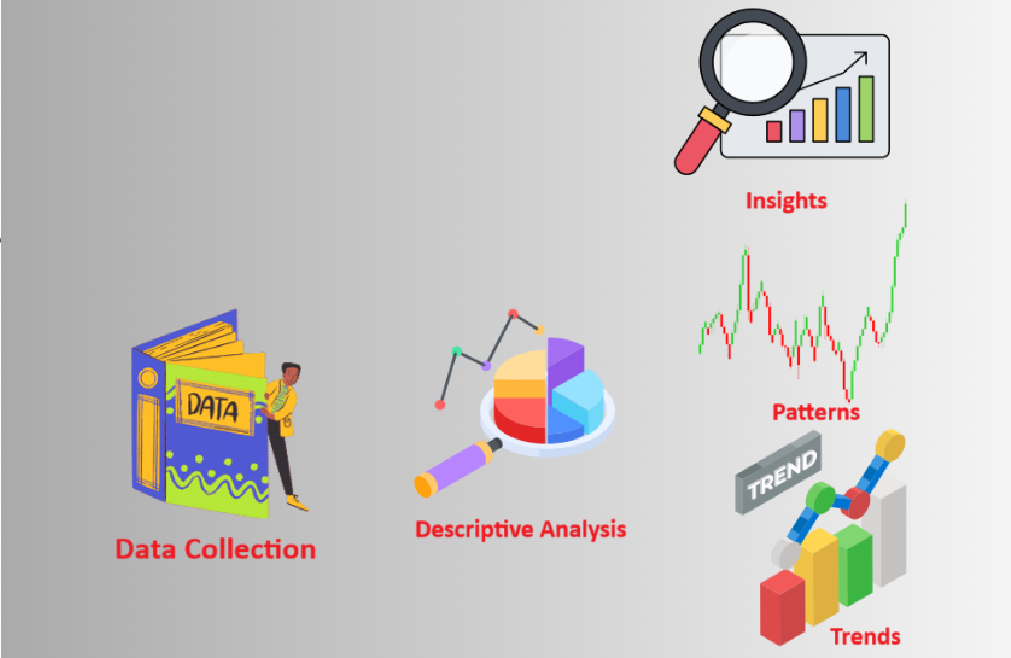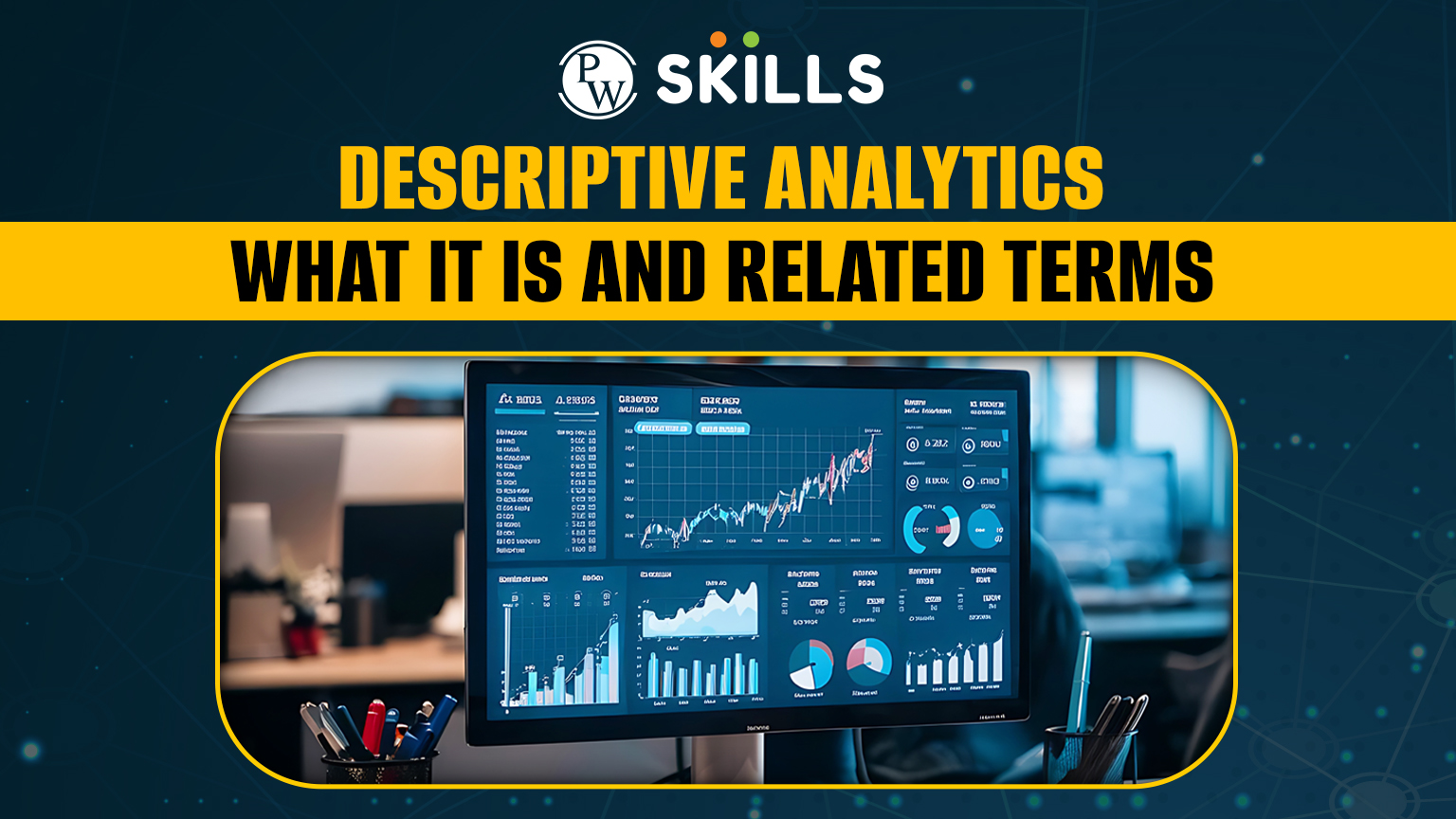Are you aware of the power of descriptive analytics? Well, it is one of the four primitive types of data analytics that can extract information from a chunk of available data. For instance, let us suppose we invested in a mutual fund and want to track how it is performing.
We can do this with the help of descriptive analytics by extracting trends from the available historical data of the mutual fund and then adjusting the investment accordingly in the next month if needed. In this article, we are going to learn more about descriptive analytics, their uses and benefits with a few real world examples.
What is Descriptive Analytics?
What took place?
What is the action required?
What is the problem?
Descriptive analytics is an explanatory version of data analytics where a group of data is analysed, interpreted, and used to inform decisions. The data interpreted can be used to uncover hidden trends, events, and actions.
Descriptive analytics is a process of collecting data from various resources, applying smarter analysis techniques, and deriving insights, patterns, and trends from the data.
Also, check, Data Collection in Data Analytics, uses, tools
Descriptive Analytics Key Takeaways
- Descriptive analytics is a method of extracting useful informations such as trends, insights and patterns by interpreting a group of data.
- Descriptive analytics is also known as explanatory analysis.
- Some common examples of descriptive analytics include customer understanding reports, return on social media initiatives, summarised reports on Google Analytics, Netflix customer analytics, etc.
How do Descriptive Analytics Help Organizations?
Descriptive analytics can be used by businesses to analyse their performance records and present them in an understandable format.
- Current business performance by tracking the key performance indicators
- Historical trends by tracking campaign performance
- Strengths & weakness by monitoring manufacturing metrics
Organizations can strengthen their operational strategies and fix gaps in growth. It provides organisation with a thorough report on the performance highlighting the strong and weak points. It also helps uncover trends and read market patterns to maintain inventory and stocks accordingly.
Also, check, How to choose the Right Data Analytics for your business?
Examples of Descriptive Analytics
Suppose we take a sales report that consists of a detailed summary of the total sales revenue for the last quarter. This report will help to analyse and find trends such as which products sold the most, which regions had the highest sales, and the time period when most of the activity occurred.
Retail Sector
In the retail sector, descriptive analytics is used to find customer behavior patterns and sales performance. Suppose, for example, an online clothing store sells its product all over India and needs to find which region saw the highest sales in the quarter.
The company will analyse their sales data of the past year to make the forecasting on which region saw the best sales in the quarter.
Marketing
In the marketing sector, descriptive analytics can be used to find customer satisfaction, the performance of a product and website. It helps the companies in getting to know which plan can give the best results after analysing all the criteria.
For example, to measure the effectiveness of an ad campaign conducted online by the organisation, such as finding how many new customers joined, how many purchased the product, how many liked the product, etc.
Finance
Descriptive analytics can also help financial institutions to measure their financial performance statistics, risk factors, and more. It helps them understand what other practices or measures they can take to manage investment, and risk and get higher returns for the growth of the institution.
For example, a monthly financial statement analysis can be used to provide a summary of the company’s financial health for a month highlighting the trends such as expense, revenue growth, and more as compared to the previous months.
Healthcare
In healthcare, descriptive analytics can be used to find the progress in a patient ‘s health chart. By analysing the past data many decisions like treatment progress, usage, etc can be determined easily.
For example, suppose the information of the patients admitted in the last year can be used to find the most frequent diagnosis, most crowded month, frequent disease, successful surgeries, etc using descriptive analytics.
eCommerce
If you have an e-commerce business then you can assess sales performance, product reviews, customer satisfaction, and more using descriptive analytics. These detailed insights help organizations take swift actions, adjusting their strategies as per the need.
For example, suppose a company can monitor customer behavior by analysing their data based on the purchases they made, the number of times they visited the site, the number of times they went without buying, the products they added to their cart more frequently, etc. An analysis based on these data can help companies find their most sought customers and give them personalised recommendations based on the insights.
Working of Descriptive Analytics

If you are wondering how descriptive analytics can be used to accomplish the above patterns, trends, and insights by analysing the collected data.
-
- Business Understanding: The first step is to understand the business goals and what methods we want to implement to obtain accurate record analysis.
- Data Collection: Data is collected from various sources such as sales, social media, operational logs, transactions, etc. Data obtained from various sources are collected are stored in a data warehouse.
- Data Cleaning and Preparation: Now the raw data is organised and inspected to check for its usability. All the redundancies and missing data are fixed and the complete data is converted in a standard form.
- Data analysis: After data is arranged properly, it is analysed and insights are collected based on the available data. Various statistics such as statistical aggregation (mean, median, mode), average, percentage, ratio, etc are used to calculate analysis such as sales performance, customer engagement, and more.
- Data Interpretation: This stage analyses the data and predicts what changes are made and its performance in the past as compared to the current data. In sales, data companies can analyze at what time sales were highest, which products were sold the most, etc.
- Reporting: All the insights, patterns and analysis from the given data is presented in the form of reports, charts, presentation, etc. These insights represent the trends, patterns and insights to help organisations take informed decisions, etc.
Advantages of Descriptive Analytics
Descriptive analytics can help businesses in making informed strategies, find trends, and more. Let us check some of the best benefits of descriptive analytics.
-
- Informed decision making: Historical data is collected and analysed to make data driven decisions rather than on strong guessings or instincts. The probability of improvement increases using descriptive analytics.
- Easily interpreted: Data is collected, processed and analysed to create dashboards and effective presentations which can be easily interpreted by a large group of people.
- Uncover trends and patterns: Based on the available data, descriptive analytics can be used to study trends and patterns used by companies to make informative decisions.
- Cost effective: Descriptive analytics is simple to implement and is cost effective as compared to prescriptive or predictive analytics.
- Broad applications: Descriptive analytics is followed in major sectors like finance, marketing, healthcare, ecommerce, etc. It is used to find patterns and extract useful insights from the collected data.
- Fault detection: Descriptive analytics can also be used to highlight discontinuity in data and highlight the gaps before they turn into problems.
Disadvantages of Descriptive Analytics
Some of the major disadvantages of descriptive analytics are mentioned below.
- Based on previous data: Descriptive analysis makes usages of past events and records to predict the outcomes in futures and patterns.
- No solutions: Descriptive analytics can be used to find patterns, insights, and patterns in data. However, it does not offer any solution based on the analyzed data.
- No Real time decisions: Descriptive analytics make use of past information collected from organsations and touch only the surface of the data. However, descriptive analytics fails to analyze data in real time which can drag you behind in the line.
- Data quality dependency: The data provided for analysis must be accurate and processed to present accurate analysis with higher accuracy. Any discontinuity in data can lead to false reports or misleading outputs.
Learn Data Analytics with PW Skills
Build a shining career as a data analyst with PW Skills Data Analytics Course . This 6 month course is a specialised upskilling program that helps you to prepare for a career in data analytics while mastering advanced tools and technologies.
. This 6 month course is a specialised upskilling program that helps you to prepare for a career in data analytics while mastering advanced tools and technologies.
Get scheduled live classes and pre recorded videos covered by our experienced industry mentors. Flaunt your skills with the help of industry-recognised certifications from PW Skills. Build your project portfolio and get hundreds of interview opportunities only at pwskills.com.
Descriptive Analytics Examples FAQs
Q1. What is descriptive analytics?
Ans: Descriptive analytics is a method of analysing and interpreting historical data to summarize the past performance and used to extract patterns, insights and trends from the past events.
Q2. What is the benefit of descriptive analytics?
Ans: Descriptive analytics help businesses in various sectors understand their customers, make data driven decisions, improve operational strategies, optimize marketing campaigns, and more.
Q3. Why is descriptive analytics important?
Ans: Descriptive analytics help businesses in different sectors such as healthcare, retail, marketing, ecommerce, etc to predict trends, improve operations, and make data driven decisions based on historical data analysis. It also presents a precise performance picture of a company.
Q4. What is the difference between descriptive analytics and predictive analytics?
Ans: Descriptive analytics makes use of past or previous data collected from organizations. However, predictive analytics is used to make future predictions on what is most likely to take place in the coming future.

